#costumes: the hague
Explore tagged Tumblr posts
Text
earth-616 dashboard simulator
🪩 thethang
it probably feels really good to get killed and revived in the negative zone tbh
372 notes
🐺 princeofpower reblogged
🧚🏼♀️ lunasncws Follow
no bc why is the new hulk lowkey gnc af...
🔄 🐺 princeofpower
i mean personally i think he looks super masc. and powerful. and muscular
23 notes
🎇 genosha-girls-were-unforgettable
can people stop making jokes about the n*gative z*ne like it's some quirky vacation?? my cousin is literally traumatized from being crawled on by resurrection worms and you're joking about it??? get over yourself
4 notes
🐌 lesbianhawkeye
so funny to me that people write ant man x reader where he uses his powers to climb in the pussy. you know damn well he's not even getting pussy at regular size!!!
16 notes
🔄 🫖 darladeeringlovebot reblogged
✖️ xmensource Follow
The Daily Bugle - Opinion: Is Professor X Really a War Criminal?
After he allegedly vaporized a bus full of orphans with his mind in August, some human rights activists have been calling for Charles Xavier — better known as Professor X, leader of the X-Men — to face charges at the Hague... keep reading
#GET HIS ASS
987 notes
🍎 longshotsbackshots
spiderman dropped some guy in a rhino costume on my car dawg i'm going to be late for work 😭😭
#this is the third time
💟 mutie4mutie
doctor doom? more like doctor dumb LOL
🔄 💟 mutie4mutie
a doombot just blew up my house
120 notes
·
View notes
Text
Ranking Men's Costumes in Renaissance Period Dramas - Part I: The Bad
Part II: The Good
I have a bone to pick with Renaissance costuming of male characters. Films and TV never seem to understand French hoods or the concept of tied up hair but the crimes committed with female characters costuming seem to pale in comparison with those committed with male characters costuming. It would be easy to find some atrocities that should be brought in front of the Hague from the bottom of the barrel shows like Da Vinci's Demons and Reign, both of which costuming is basically black leather jackets, pants and boots. If we're lucky, they have some vaguely Renaissance details imitating doublet or jerkin. But these shows make absolutely no effort, even the women's costumes are straight from modern fast fashion shelves (often literally). But I have noticed that even costuming that has some effort otherwise put behind it, still costumes male characters with the most boring costumes and minimal effort. The Tudors didn't have good costumes, but there's some effort towards historical immersion, even if quite lackluster, but the men's costumes are still so sloppy.

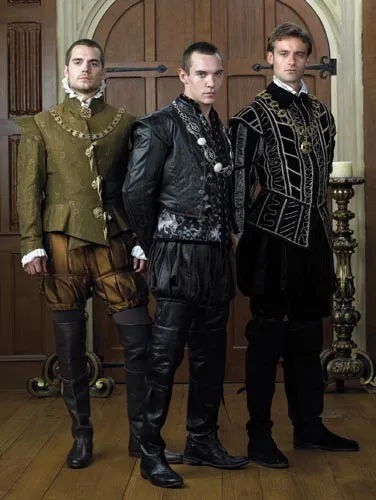
My theory is that they think men's Renaissance fashion was too goofy and embarrassing to fit their cool and sexy main male characters. Also men dressing up and taking care of their appearance? That's obviously homosexual behavior, and these hot men who the main female characters are fawning over are Manly and Heterosexual. So they don't dress up in fancy clothing or colour!
To give a fair change to the costuming, I will be selecting only shows and movies which have good costuming for the female characters. If they are not even trying, it feels kinda pointless to point that out. I have selected 10 period dramas. I haven't seen all of them so I'm not going to analyse the costuming any deeper than how good and well made they look and how well they evoke the historical setting. I don't demand historical accuracy, but I will be more harsh on that front if the women's costumes are succeeding in that. But one of the point of period dramas is to immerse into a historical setting, so if the costumes can't evoke that feeling, I think they have failed. Obviously this is not some objective ranking, but my opinions. This is in two parts (because of Tumblr image limits), so I'll start with the five worst costumes in order of best to worst.
5. Ever After (1998)
Ever After is supposedly set in Renaissance France, but the costuming resembles late 15th century and early 16th century Italy much more. It's not very historical, and clearly not really trying to be, going for more of a fantastical style. It works, I think because they make it cohesive and very pretty.
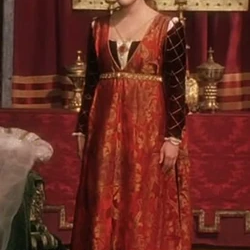
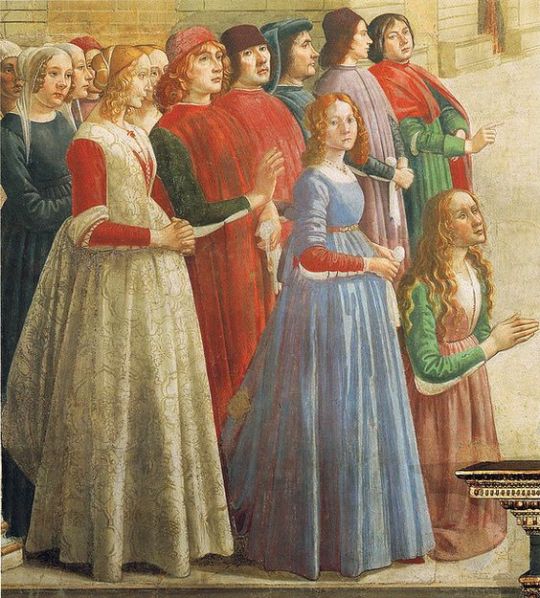
Men's costumes resemble also resemble Italian styles. The Lombardian style sleeves, short doublets and tight pants land it right there. The men's costumes are much more boring than the fun and fantastical women's costumes, but they got the least worse spot in this worst costumes list for several reasons. The pants are actually tight and they have codpieces. The sleeves are actually really great I love them. And there's no leather pants or doublets.
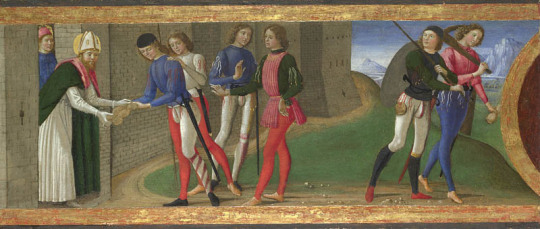
And look at this, at least one doublet is closed with lacing!! (I apologize for the very low image quality, it was the only picture I found of that costume.)


The biggest gripe I have with the costumes are the boots. Just let these male characters show of their calves. At least not everything is black but the lack of colour is still disappointing too.
4. Becoming Elizabeth (2022)
The female characters have quite excellent costuming. The fabrics are rich and gorgeous, the bodices are extremely smooth and crisp, some of the best I've seen, partlets are on point and correctly used. My only complained is the occasional open hair and yet another case of the weird upward pointing crown-like French hoods.

French hood didn't have any crown shaped thing, it was a hood and the headpiece is actually several headpieces made to reveal the lining of the hood in a crescent shape. So it is very much flat against the head. (I've written about French hood's construction before.) And sure they look more early Tudor fashion, the sleeves should be much more dramatic and the bodice elongated. Like here's a portrait of the actual young Elizabeth. But I think the detailing, great construction and good looking materials make the costuming beautiful and feeling enough like Tudor era.

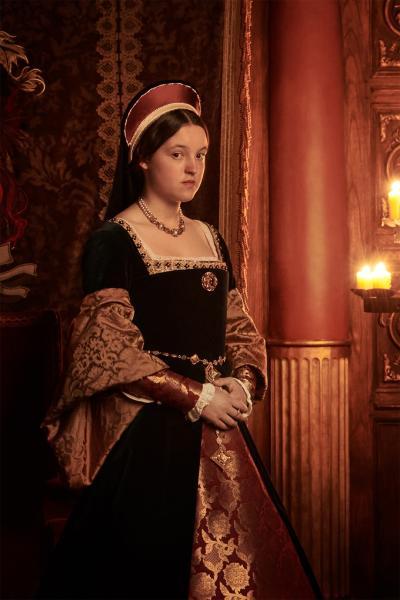
So how does the men's costuming hold up? Pretty okay, which is why this show is so high up in the list. I haven't seen any leather pants on anyone. Leather jerkins were an actual thing, they just weren't black, and though the leather jerkin in the show was dark brown and not smooth hide, it was not black so that's something. Edward VI does have actual stockings and Renaissance shoes, which is great, but he is a kid and I didn't see any grown man rocking that style which is very cowardly behavior imo. There's some colourful silk jerkins in there too. And they even could get away with all black since that was very fashionable at the time. They are all wearing slashed trunk hose. AND! They have actual accurate codpieces sticking up! That is so rare especially in this period when the codpiece was not just a flat piece of fabric.
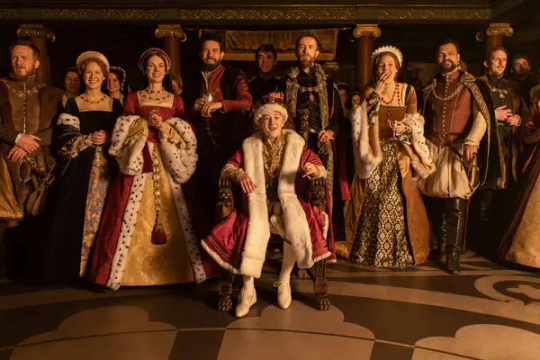
Unfortunately this is where the good things I have to say end. All of these court people are for some reason wearing riding boots inside and everywhere all the time. The hose are way too long and the jerkins are way too short. The hose should be just peaking under the hem of the jerkin. Obviously none except the kid uses thigh high stockings. One of the worst things though imo is the lack of structuring in the men's costumes. The women's costumes are so well structured, but the men's costumes are just wet rags hanging on them? The doublets were heavily structured to create a pigeon chest and hourglass effect.
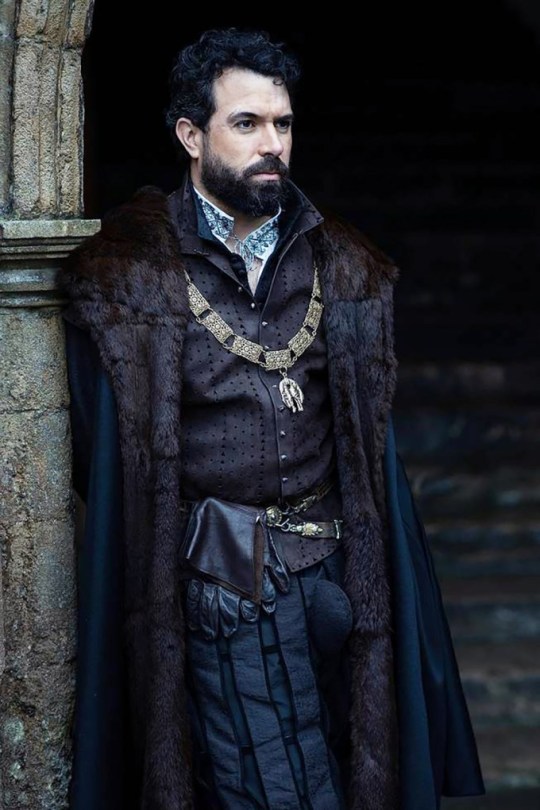
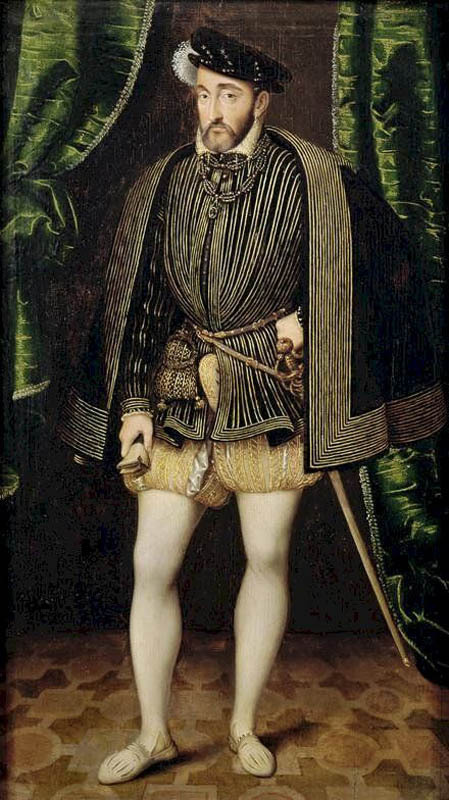
In conclusion, there's clearly some effort made, some very nice historical details, but the overall look is very costumy and sloppy because of the lack of structuring and lacks the historical silhouette.
3. Mad Love (2001)
The movie is set around 1500 Neatherlands (and Spain). I think many of the costumes are gorgeous (like the examples below), though overall the costuming is quite inconsistent. Most of it fits at least okay to the time period and setting, though the red dress here is more along Italian styles, but not entirely off either for early 1500s Low Countries. Some costumes though are 50 years from future. Of the women's costumes alone, this would probably be the worst costuming on this list, though I think better than most Renaissance costuming, which is why it still ended up on this list.
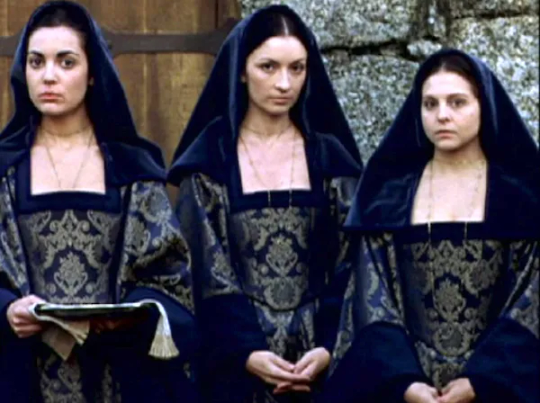
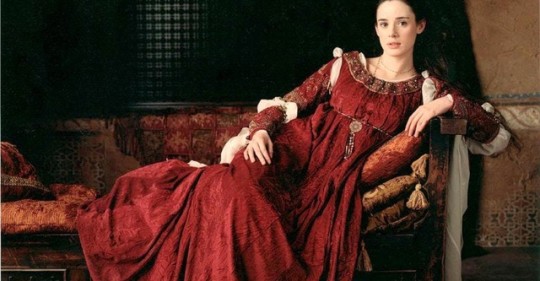
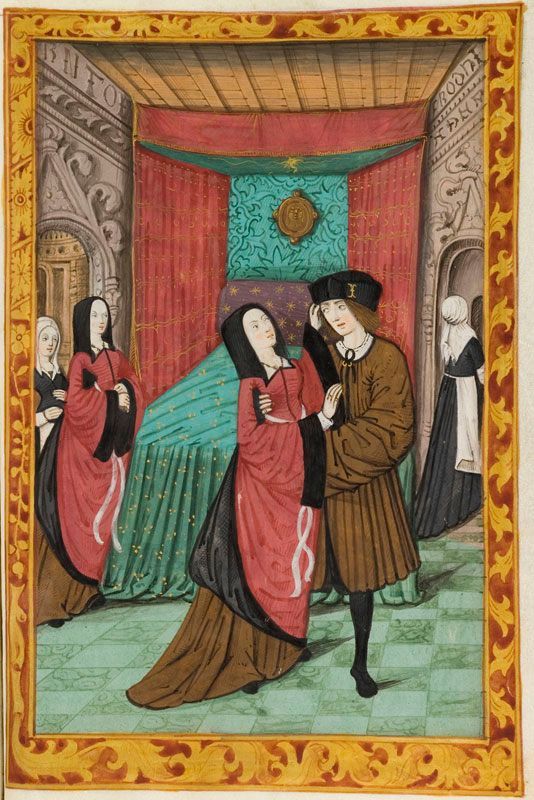
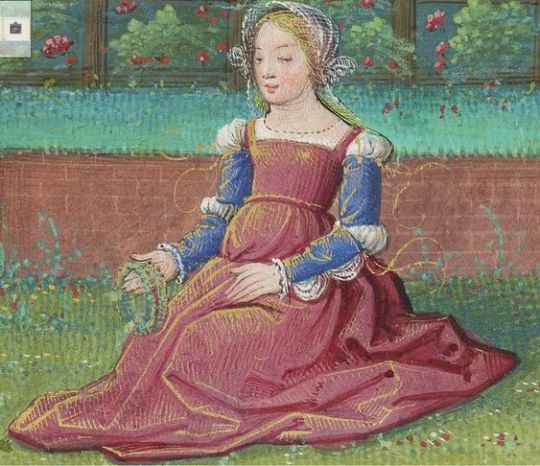
The men's costumes resemble more early 16th century German fashion than Low Countries fashion, which was more similar to French fashion than German. In the red ensemble there's some weird jerkin looking overgarment, but jerkins were not a thing yet and they were never in this style. I will excuse the lack of codpiece since in Low Countries' fashion it was hidden under longer overgarments, even though in this more German style it would have been left in view. The hose are no where near fitted enough, and the boots should not be here at all. Overall this is kind of a mess, but it is better than the last two. We have skirt, we have weird sleeves, open neckline and most importantly, we have colour. Also while this shoulder-length curly hair wasn't in fashion outside Italy at the time, I still appreciate the sluttiness of it.


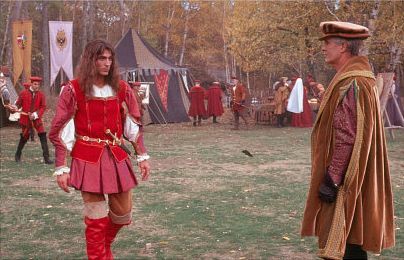
2. The Borgias (2011-2013)
Now we are getting to the territory, where the lack of effort is starting to be very obvious. Like the costumes till now were not particularly good, but clearly they at least attempted, even if not very hard. So, The Borgias. The show is set in the early 1500s Italy. The women's costumes are gorgeous. Not always the most historically accurate, but at least close enough and very pretty.
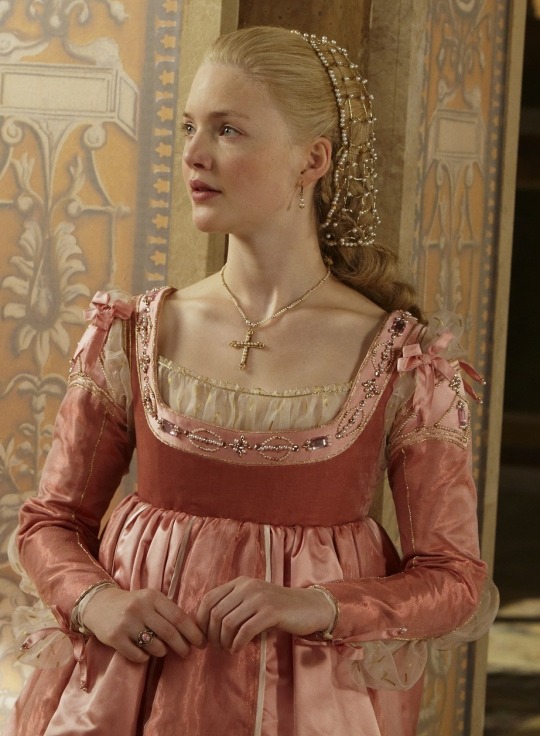
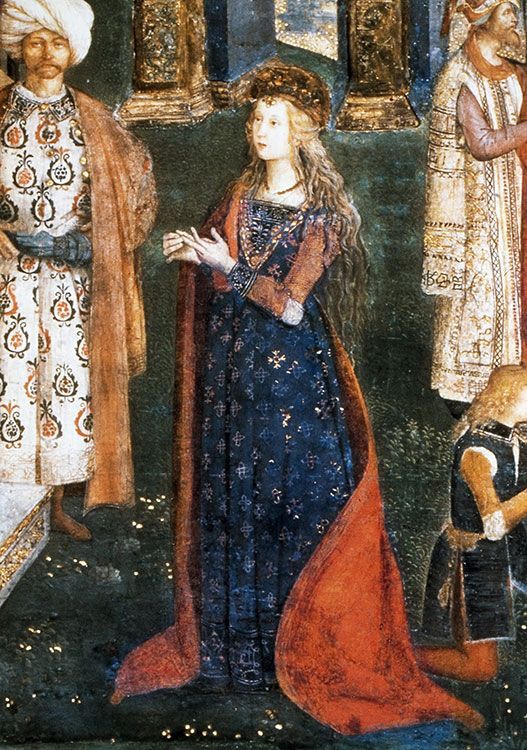

The men's costumes however... a deep sigh. Some of them are not that bad, like this first one has kinda Lombardian sleeves and a too small doublet showing off the lacing (in Italy the lacing was almost always ladder-lacing though regardless of gender, but it's something I guess). Most of it though, especially of the leading men, who are supposed to be cool and hot, is absolutely garbage. The same black leather jackets and pants seen in the bottom of the barrel shows. Like the costumes of the female characters and some of the male characters feel like they are from two completely different shows. Like sure they have codpieces, but their pants are so loosely fitted they wouldn't even need the codpieces. (I explain the use of codpieces in this post). And of course they have boots. Of course. In Italy it was even common to not wear shoes at all, they just sewed leather soles at the bottom of the hose. And even the men's costume that have tiniest bit of effort, are so dark and lacking in colour, when the most fashionable young men at the time wore these wildly multicoloured hose and doublets. The feeling I get the showrunners were so god damn afraid of giving the cool male characters any elements or details that could in anyway seen as feminine today, they stripped all the historical elements away. Like they couldn't even give Cesare lacing, they had to make it Manly Buckles?? It's such an insecure performance of masculinity. I admit the last image here is the worst offending example and there were some with a bit of color even, but in other ways most of it is exactly this bad. I will have to hand one thing to them though. They did manage to get the slutty shoulder-length hair right.
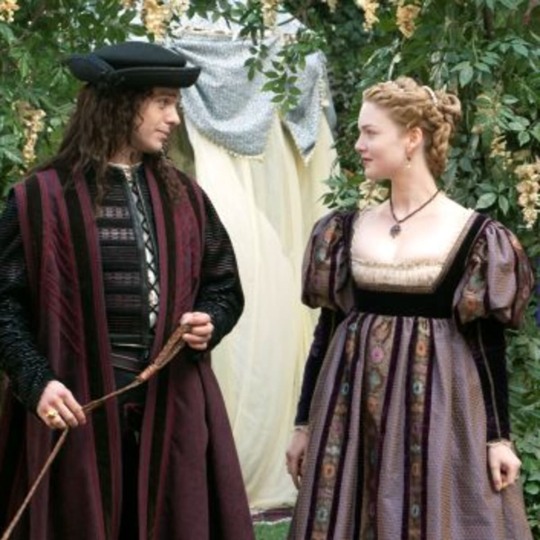
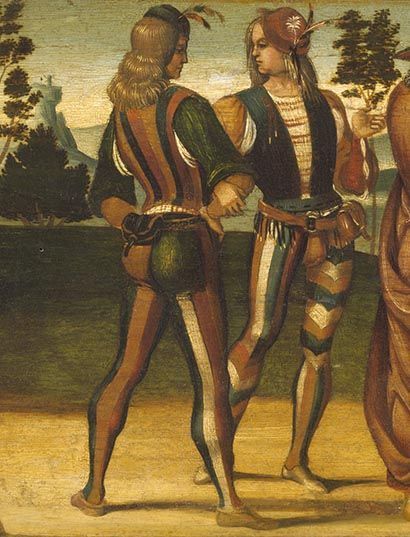
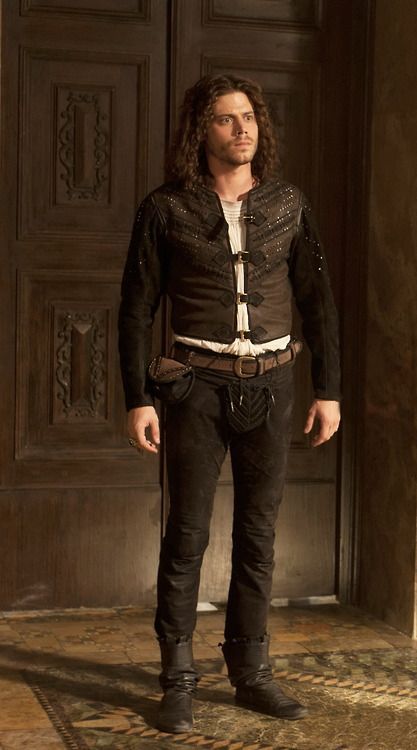
If this man is supposed to be sexy, prove it to me by showing his ass with lovingly fitted hose.
1. Rosaline (2022)
This is roughly set in the same time in Italy too as The Borgias, based on women's costumes, I'd say at the very end of 15th century. And those women's costumes are honestly great. They even have hand-sewn eyelets, ladder-lacing and cartridge pleats. Even some of the most high effort costumes don't get these details right. Honestly I only have issue with the hair, the hair goes from okay or outright terrible. They even made this super historically accurate Renaissance apron for a maid.
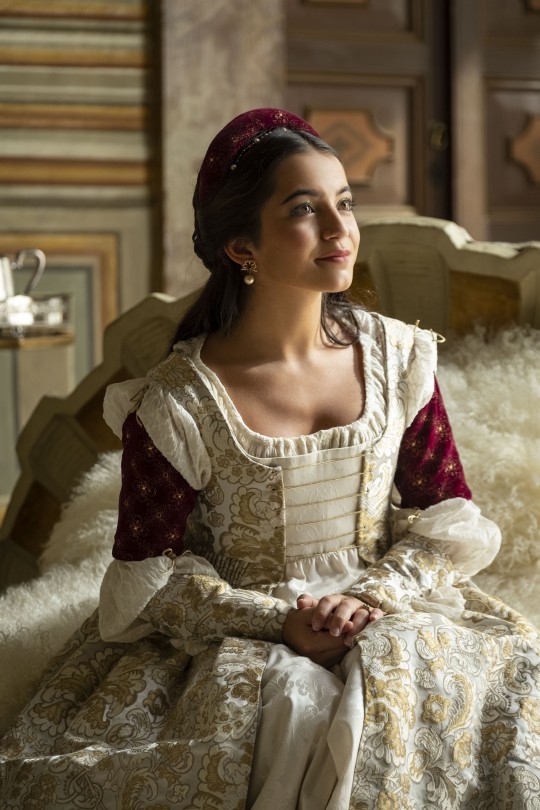
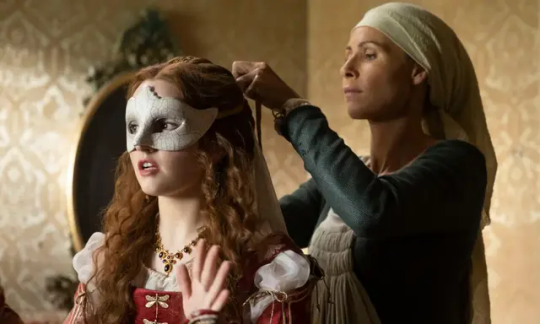
This got the lowest ranking so you know what comes next. The men's costuming is absolutely unacceptable. I feel like it would be excessive to even describe all the ways these costumes fail since to me they are so obviously bad. The difference between these women's dresses with such gorgeously crafted details and these men's costumes that give absolutely nothing is so stark and gives such a massive dissonance. They are just wearing modern skinny-ish pants, all the colors are so muted and dark, there's no shape, no structure, no codpieces, just sloppy bland jackets and pants. Even less effort than men's costumes in The Borgias have. Except one thing they have over The Borgias, they were able to ladder-lace that doublet. Otherwise these are just bland, boring and actively ugly. And it's so weird that they took this "gritty gruff "realistic"" route, when it's a comedy about Romeo and Juliet? You afford to be a little goofy with a comedy and yet you did this.
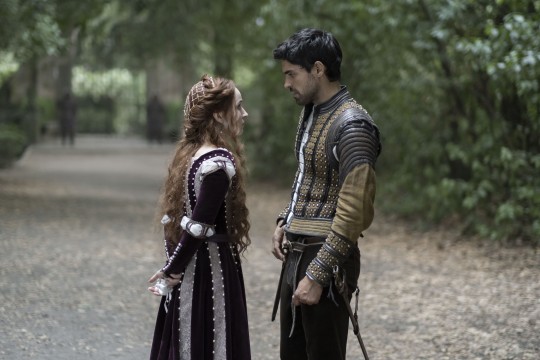
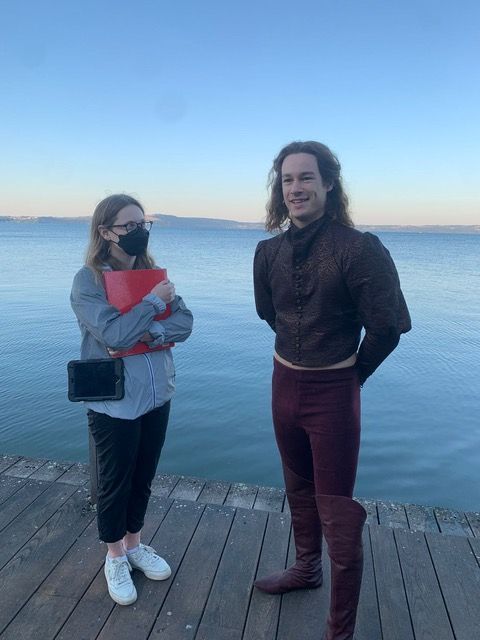
Extreme disappointment, do better.
Part II: The Good
#historical fashion#period drama#historical costuming#costuming#period film#costume drama#renaissance fashion#renaissance costuming#historical fiction#ever after#becoming elizabeth#the borgias#rosaline 2022
271 notes
·
View notes
Text
THIS DAY IN GAY HISTORY
based on: The White Crane Institute's 'Gay Wisdom', Gay Birthdays, Gay For Today, Famous GLBT, glbt-Gay Encylopedia, Today in Gay History, Wikipedia, and more … November 24



1632 – Baruch Spinoza, the Dutch philosopher was born on this date (d. 1677). One of the great rationalists of 17th century philosophy, he laid the groundwork for the 18th century Enlightenment and modern biblical criticism. By virtue of his magnum opus, the posthumous Ethics, Spinoza is also considered one of Western philosophy's definitive ethicists. He was raised and educated in the Orthodox Jewish fashion, also studying Latin and was thoroughly familiar with European humanism.
What exactly is it that caused him to be excommunicated from the synagogue when he was only 24 years old? Many scholars have speculated that the horror Spinoza inspired in the Jewish community may have come not only from his espousal of advanced economic theories, but from his espousal, as well, of Greek love among impressionable students in the liberal circle where he taught. A Dutch physician, J. Roderpoort, wrote at The Hague in 1897: "Spinoza excites the youth to respect women not at all and to give themselves to debauchery." Was Spinoza merely teaching the Greek and Roman classics, with their inevitable passages on pederasty? What were Roderpoort's motives for discrediting the Jewish philosopher? Was Spinoza, in fact a pederast? It's all open to speculation.


1933 – A law was passed in Germany to allow surgical castrations as a crime prevention measure and a therapeutic treatment for homosexuality.


1930 – Albert Wolsky is an American costume designer. He has worked both on stage shows as well as for film, and has received two Academy Awards, for his work on the films All That Jazz and Bugsy.
Wolsky was born in Paris, France, but during World War II, he and the rest of his family fled to the United States to escape the German occupation. After graduating from the City College of New York, he served in the army from 1953–56, spending most of his enlistment in Japan. Once he returned to the United States, he began working in his father's travel agency. However, he decided to change careers and took an assistant's job with notable costume maker Helene Pons.
Wolsky became a well-regarded costume designer, working both on Broadway and in the motion picture industry.
His longtime partner was actor James Mitchell.


1933 – René Enriquez remembered for his role as the perpetually worried Lieutenant Ray Calletano on Hill Street Blues.
Born in San Francisco, California, he attended San Francisco College and San Francisco State University. He served with the U.S.Air Force during the Korean War. He was a member of the American Academy of Dramatic Arts in New York from 1958. He was also the nephew of General Emiliano Chamorro, one-time president of Nicaragua.
As a film actor, René was known for Bananas (1971), Harry and Tonto (1974), Under Fire (1983) and The Evil That Men Do (1988).
He also appeared in episodes of Charlie's Angles, Benson, WKRP in Cincinnati and Quincy.
In biographies and intervies, Enriquez told of a wife who had tragically died. It was a lie. He was a homosexual bachelor who contracted AIDS in 1987. As he became more and more ill, he told his friends and fans he was suffering from cancer. He died in March 1990.
His publicist and long-time friend Henry Bollinger revealed, "René told me he was dying of pancreatic cancer. He never told me anything about a gay lifestyle."
The true cause of his death only became known when his death certificate was published. Cause of death was given as "cytomegalovirus enteritis due to Acquired Immune Deficiency Syndrome (AIDS)"
The only people privy to René's terrible secret were his two sisters and his 25-year-old Hispanic lover.


1940 – Arthur Tress, American photographer, born. The uncompromising, poetic imagery of American photographer Arthur Tress is the stuff of dreams, called forth from the artist's reckoning with the world and his place in it.
A New Yorker, he began his photographic career at age twelve, making snapshots of dilapidated mansions and Coney Island decay. An introverted child of divorce, Tress moved between two worlds--his lower-class mother's neighborhoods and his nouveau riche, remarried father's more prosperous one, observing and eventually photographing both milieus.
As he recalls, from a very young age he was already aware that his sexuality was different from most of his classmates and he was drawn to subject matter that was similarly marginalized and different.
During his studies at Bard College, Tress explored painting and filmmaking but was ultimately committed to still photography. Although he worked in a documentary style, from the beginning his imagery was characterized by a surrealist sensibility.
After graduation Tress traveled the world, in part financed by his father and also supporting himself by making ethnographic and documentary images. During his travels he became increasingly influenced by his experience of other cultures, particularly in matters of spirituality and consciousness.
Tress's first book, The Dream Collector (1972), was an attempt to visualize children's dreams, often featuring children whom Tress had interviewed as models. His second book, Shadow: A Novel in Photographs (1975), showed "portraits" of the photographer's shadow and explored the idea that the shadow literally and metaphorically represented one's dark side.
Theater of the Mind (1976), which included an essay by his friend and mentor, gay photographer Duane Michals, explored adult fantasies and marked the introduction in Tress's work of overtly erotic imagery. As Tress explained, he sought to make "photographs [that] attempt to make explicit . . . sexual passions and ironies."

"Superman Fantasy"
Around 1972 Tress consciously began to include what he called "the more intimate spheres of a gay sexuality and homoerotic fantasy life." Facing Up (1977-1980), alternately titled Phallic Phantasy, was Tress's first explicitly conscious exploration of his sexuality in which he exclusively photographed male nudes.

"Groom with White Arabian"
Many of these images were included in Tress's homoerotic homage, Male of the Species: Four Decades of Photography of Arthur Tress (1999), which culls imagery from Tress's forty-year career of exploring the male body and sexuality. The sensual photographs, sequenced in a loose narrative of experience from youth to death, matter-of-factly infuse male sexuality with humor and irony.
In contrast, Tress's obsessive constructions made and photographed for the Hospital series (1984-1987) are a garish, nightmarish reckoning with health-related issues and death in the era of AIDS.


1954 – James Lecesne is an American actor, author, screenwriter, and LGBT rights activist best known for his screenplay of the Academy-award winning short film Trevor. He has written several books including Absolute Brightness and Virgin Territory, and is also active in the entertainment industry as an actor and producer.
Lecesne wrote the 1995 short film Trevor, which won the Academy Award for Best Live Action Short Film. He based the screenplay for Trevor on a character from his one-man show Word of Mouth. Also in 1995, Word of Mouth won the Drama Desk Award for Outstanding One-Person Show. Word of Mouth was directed by Eve Ensler.
In 1998, on the night Ellen DeGeneres hosted the television debut of Trevor on HBO, Lecesne co-founded and launched The Trevor Project as the first nationwide 24-hour crisis intervention lifeline for lesbian, gay, bisexual, transgender and questioning youth, including phone, in-person and online life-affirming resources such as Trevor Lifeline, TrevorChat, TrevorSpace, Ask Trevor and Trevor Education Workshops. The Trevor Project has been supported by a wide variety of celebrities, including Daniel Radcliffe, Neil Patrick Harris, James Marsden, Kim Kardashian, George Takei, and Anderson Cooper.


1984 – Wolf Hudson is a Dominican American film director, street dancer and pornographic actor of heterosexual, homosexual, and bisexual films.
Hudson started his adult film career in 2006 at age 22 in New York when he was cast by Michael Lucas in the Lucas Entertainment project Michael Lucas' Auditions Vol. 22. He moved to San Francisco in early 2007 to focus on his career in the pornographic film industry full-time and to work for gay pornographic film studio Factory Videos.
In August 2008, he co-starred in the GayVN Award-winning bisexual film Shifting Gears , directed by Chi Chi LaRue. The film stirred up controversy when the term "Straight-for-pay" (a play on word for Gay-for-pay) was coined to reference performer Blake Riley's first encounter with a woman (Shy Love) and liking it. Riley received most of the criticism, but so did Hudson and LaRue.

Hudson appeared in the third season of the Canadian TV show Webdreams , which followed Jet Set Men directors Chris Steele and Chad Donovan.
Hudson turned down an offer to appear on a January 22, 2009, episode of The Tyra Banks Show concerning Gay-for-pay performers. He expressed his reservations about appearing because of how the show could twist things around to make the guys look bad.
Hudson identifies himself as heterosexual, even going as far as to call himself a "sexualist" instead of gay-for-pay. He is quoted as saying, "I am not conventional. I am not fully straight because I do gay porn, but I'm not bi because I don't date men in my personal life. I define myself as a 'sexualist'. I think Chi Chi LaRue came up with that term and it works for me."


1991 – Freddie Mercury, lead singer for Queen, died of complications from AIDS. It was only the day before that he acknowledged that he had the disease. He left most of his estate to a former girlfriend, Mary Austen, who cared for him during his final months.


2015 – The Vietnamese National Assembly passes a law that allows those who have undergone sex reassignment surgery to register under their preferred sex. However, sex reassignment surgery is illegal in Vietnam. The law comes into effect in 2017.

On Gay Rights, Vietnam is Now More Progressive Than America


8 notes
·
View notes
Text

Woman Weaving a Crown of Flowers
Artist: Godfried Schalcken (Dutch, 1643–1706)
Date: c. 1675-1680
Medium: Oil on panel
Collection: The National Gallery of Art, Washington, DC, United States
Description
This charming portrayal of a woman who daydreams while weaving a crown of flowers is a fine example of Godefridus Schalcken's refined manner of painting. Its meticulous technique, particularly evident in the rendering of the costume, reflects Schalcken's connection to the Leiden fijnschilders (fine painters), who specialized in small genre scenes executed with extraordinary attention to detail. These gemlike pictures, filled with brilliant touches of color and light, found favor among collectors throughout Europe.
Woman Weaving a Crown of Flowers almost certainly alludes to the yearnings of a young woman for love and marriage. The crown of flowers refers to both of these themes, which are reinforced by the cupid atop the fountain and the young lovers in the distance. The crack in the stone base of the fountain nevertheless offers a warning that, over time, even the most solid foundation of love is fragile.
As a young man, Schalcken moved to Dordrecht, where he was apprenticed to Samuel van Hoogstraten (1627–1678). He then trained in Leiden under Gerrit Dou (1613–1675) and went on to establish himself as an independent master in Dordrecht by the mid-1660s. In 1692 Schalcken moved to the court of King William III and Queen Mary at Windsor, where for seven years he painted portraits of the Dutch-born king and the English aristocracy. In 1699 he settled in The Hague, where he worked for the rest of his life.
#painting#oil on panel#genre art#woman#dutch art#daydreaing#godfried schalcen#17th century#weaving#crown of flowers#fountain#cupid#lovers#distant landscape#costume#hat
7 notes
·
View notes
Text
collaboration spotlight — Epic Christmas Movie Medley by Peter Hollens
youtube
Music is a big part of Christmas season festivities, and holiday movies are no exception. Some existing songs have inspired the creation of films. Others have been written specifically for the movies they're in. Either way, a catchy tune has the power to bring a smile to your face and maybe even sing along. For this feel-good medley, Peter got his family and a couple new friends in on the act.
Details:
title: Epic Christmas Movie Medley (feat. Brian Hull & Geoff Castellucci)
performers: Peter Hollens, Evynne Hollens, Ashland Hollens, Brian Hull, & Geoff Castellucci
original songs / performers: "Rudolph the Red-Nosed Reindeer" by Burl Ives in Rudolph the Red-Nosed Reindeer (1964); [0:33] "White Christmas" by Bing Crosby & Marjorie Reynolds in Holiday Inn (1942); [1:08] "Frosty the Snowman" by Jimmy Durante in Frosty the Snowman (1969); [1:48] "Baby It's Cold Outside" by Esther Williams, Ricardo Montalbán, Betty Garrett, & Red Skelton in Neptune's Daughter (1949); [2:20] "Christmas Time Is Here" by the cast of A Charlie Brown Christmas (1965); [2:45] "The Snow Miser Song" by Dick Shawn & [3:13] "The Heat Miser Song" by George S. Irving in The Year Without a Santa Claus (1974); [3:36] "You're a Mean One, Mr. Grinch" by Thurl Ravenscroft in How the Grinch Stole Christmas! (1966); [4:29] "Santa Claus Is Comin’ To Town" by Fred Astaire in Santa Claus Is Comin’ To Town (1970)
written by: "Rudolph the Red-Nosed Reindeer" by John David Marks; "White Christmas" by Irving Berlin; "Frosty the Snowman" by Walter "Jack" Rollins and Steve Nelson; "Baby It's Cold Outside" by Frank Loesser; "Christmas Time Is Here" by Vince Guaraldi & Lee Mendelson; "The Snow Miser Song" & "The Heat Miser Song" by Maury Laws & Jules Bass; "You're a Mean One, Mr. Grinch" by Theodor "Dr. Seuss" Geisel & Albert Hague; "Santa Claus Is Comin’ To Town" by J. Fred Coots & Haven Gillespie
arranged by: Peter Hollens
release date: 18 December 2020
My favorite bits:
introducing all the characters they're playing so folks can identify the movies, even the ones without songs in the medley
Ashland's sweet, clear tone in "Frosty" ⛄
Evynne's lovely crooning on "Baby It's Cold Outside" and her reactions as Peter shoves more and more food into his mouth
Snow Miser Peter and Heat Miser Brian messing with the characters in other sections of the screen ❄🔥
Geoff's luscious bass and Peter's semi-operatic tone in "Grinch"
their bouncy, syncopated take on "Santa Claus"
following ♫ "You better not pout" ♫ with "You'll shoot your eye out!" from A Christmas Story 🤭
reprising all the songs in the build-up to the ending
Peter's adorable fatherly pride in the outro





Trivia:
Because the video title is fairly long, many first-time viewers were surprised by Brian and Geoff's cameos since their names got cut off on the main YouTube page.
Geoff pops up in costume as Max the dog, who the Grinch conscripts into being his reindeer. VoicePlay's jazzier version of "You're A Mean One, Mister Grinch" (in which Layne briefly wore the antler headband) was released a few weeks earlier.
Brian first collaborated with Peter for his "Epic Disney Sidekicks Medley" the year before, and they have made occasional appearances in each other's projects over the years since.
Geoff and Brian both returned the following year to get spooky in Peter's cover of "This Is Halloween" from The Nightmare Before Christmas.
This video was the opening segment in a 25-minute compilation of Peter's holiday songs four years later.
Although they didn't include the song — because it's not from a movie, and also Ashland didn't want to — a commenter did note that it was fortuitous timing that the kiddo had lost his two front teeth before they filmed this.
#Peter Hollens#Brian Hull#Geoff Castellucci#music video#music#music medley#Christmas music#music from movies#video
3 notes
·
View notes
Text
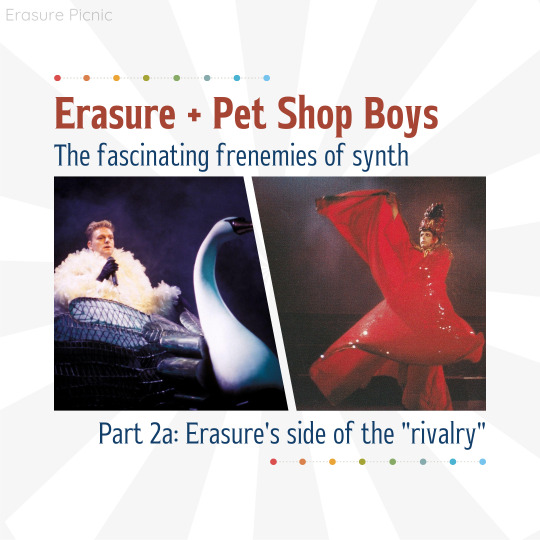

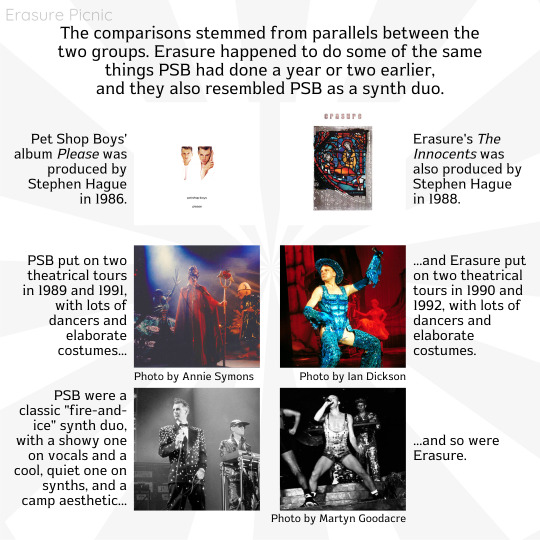
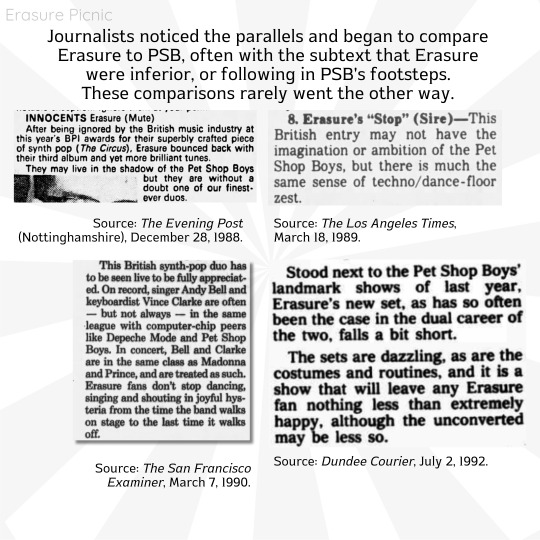
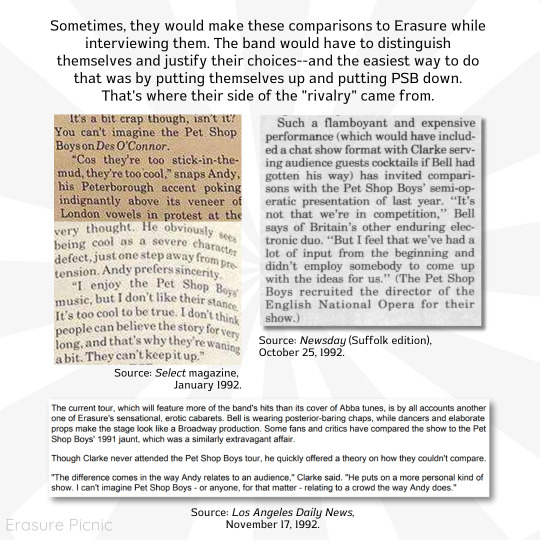
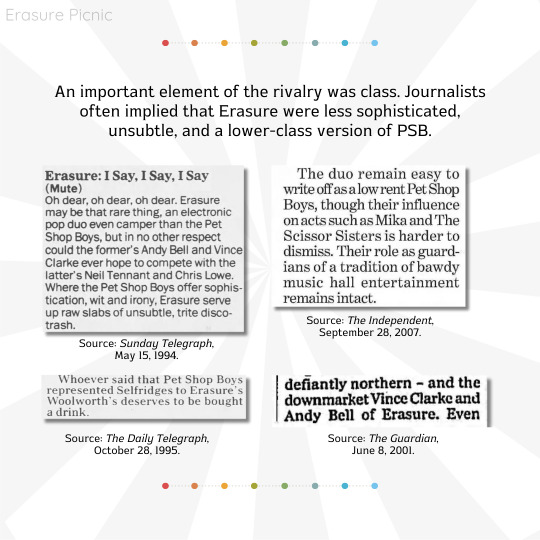
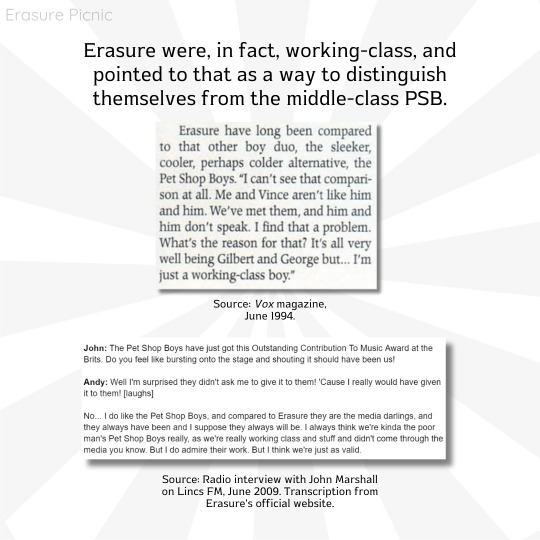
This post will cover why journalists compared Erasure to PSB, provoking their side of the “rivalry”.
Why “rivalry”? Their feud wasn’t inspired by any personal hate for each other. Even if Andy Bell had struck out first, it didn’t provoke a response from PSB–not yet, at least. Instead, the “rivalry” was largely a creation of journalists, who had started to compare the two groups. (This was already a cliche by 1989, as one article attests.) Usually, these comparisons went one way. There were far, far more articles focused on Erasure that compared them to PSB, than the reverse.
This was due to parallels in both artists’ careers, with Erasure doing many of the same things that PSB had done. In 1988, Erasure worked with producer Stephen Hague; in 1990 and 1992, they put on lavish, theatrical tours with extravagant costumes and lots of dancers. PSB had done all of these things a year earlier. Erasure also resembled PSB, in that they had a bolder, showier singer and a quieter synth player.
These parallels led many critics to assume that Erasure were merely following in PSB’s footsteps. As a result, when they would write pieces on Erasure, they would compare them to PSB. Since critics largely preferred PSB to Erasure, these comparisons were often unfavourable to Erasure. This tendency to compare the two bands shot up dramatically in the 1990s, when they were the only two synth duos of their type who had survived the 80s.
They didn’t just limit it to articles and reviews. They also did it in interviews with Erasure themselves. When interviewers would ask them about PSB, Erasure would have to distinguish themselves and justify why they did things their way. The easiest way for them to do that was by putting themselves up and putting PSB down. That’s where Erasure’s part of the “rivalry” stemmed from–in large part, because of the comparisons. Unlike PSB, Erasure hardly ever commented on their synth-pop peers unless specifically asked to. (Part 1 of 2 - see the other part in the comments)
An important element of the rivalry was class. Critics who put down Erasure in favour of PSB often implied that Erasure were a lower-class version of PSB, such as in the common phrase “poor man’s Pet Shop Boys” (a description Erasure later embraced). In fact, while PSB were middle-class, Erasure WERE working-class–and they pointed to that difference as a way to distinguish themselves. A full look into the class dimensions of Erasure and PSB could easily be its own post. It’s not in the scope of this one, but if you’re interested in reading how class played into the groups’ fanbases, this is explored in an excellent article by Lynsey Hanley, called How I became middle class (The Guardian, 2016).
Comparisons of Erasure to PSB appeared in all sorts of publications–mainstream, indie, and gay. However, the reverse–PSB being compared to Erasure–tended to be limited to the gay press, who noticed other distinctions between the bands. In the next post, we’ll look at the way the gay press treated the two groups, along with PSB’s side of the “rivalry”.
#erasure#erasure band#pet shop boys#vince clarke#andy bell#neil tennant#chris lowe#pet shop boys vs erasure
41 notes
·
View notes
Photo

Shaman hat, Nepal.
Rare example of Nepali Shaman hat. Nepali shamans - Jankhri & Dhami who are spirit mediums and shamanic healers often have headgear with bird feathers or porcupine quills, kauries and coins attached.
The trisule, an iconic symbol for Shiva, at the crest is also frequently incorporated into their costume. Often those shamans are from the Tamang (and perhaps also Magar) ethnographic groups in NW Nepal.Materials: cloth, porcupine quills, kauries, iron and coins.Height 28 cm - 11 inches.
Provenance: From the estate of Dutch sculptor Theo van der Nahmer and his wife photographer Marianne Dommisse, The Hague, The Netherlands.
24 notes
·
View notes
Text
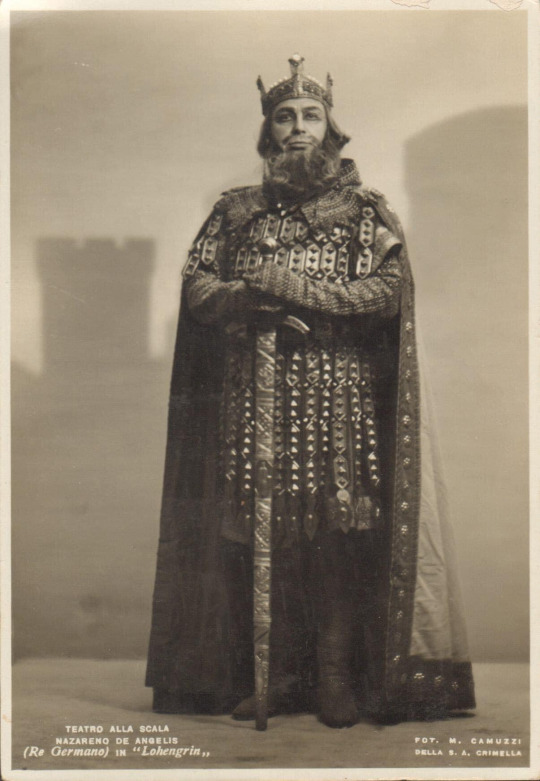
Here we see the Italian bass Nazzareno de Angelis (1881 – 1962) as King Henry from Lohengrin. I love the imposing costume and regal pose.
De Angelis was born at L’Aquila on 17 November, 1881 and began his musical life as a boy soprano, first with local choirs, then at the Capella Sistina in the Vatican. After his voice lowered, he studied with one Dr. Faberi at the Accademia di Santa Cecilia in Rome. For several years, he and his mentors wondered about his true vocal placement, and he studied both baritone and bass scores with equal intensity. The top of his voice was tremendous, but it became increasingly clear that it was centred where kings, prophets and devils live. His last two years at the Accademia were spent developing repertoire, and he gave several recitals there before making his opera début at the Comunale of L’Aquila in May of 1903 in Linda di Chamounix, followed by an opera called“L’Educate di Sorrento, by E. Usiglio, at the same theatre.
Hearing of his enormous success the management of Rome’s Teatro Quirino immediately engaged him, and, in early July, he débuted in Norma. He subsequently appeared at the Teatro Adriano as Il Spettro in Hamlet, to the Ofelia of Maria Barrientos and the Hamlet of Battistini, followed by Rigoletto and Tosi Orsini’s Yanthis. In 1904, after some twelve performances of La Gioconda at the Teatro Lirico of Milan, he appeared at Santa Maria Capua Vetere as Colline and at the Quirino in La Favorita, Il Barbiere di Siviglia (Basilio), Carmen (Zuniga), Ernani, Norma and Rigoletto. Carlo Galeffi was his Rigoletto in several performances. He toured the Netherlands from December of 1904 to May of 1905, singing such diverse roles as Dr. Grenvil in La Traviata, Zuniga in Carmen, Sparafucile in Rigoletto, Ferrando in Il Trovatore, Fouquier-Tinville in Andrea Chénier, Tom in Un Ballo in Maschera, Angelotti in Tosca, Basilio and Raimondo in Lucia di Lammermoor. The company gave performances in Amsterdam, Rotterdam and The Hague.
In the Autumn of 1905 he appeared at Mirandola in La Gioconda, at Parma’s Teatro Reinach in Rigoletto and Faust, and at Cagliari’s Teatro Regina Margherita as Alvise, along with those first historic performances of Mefistofele. Gaspare Nello Vetro’s Teatro Reinach says of his Faust Mefistofele: “The young Nazzareno De Angelis, now at the outset of his career, received the greatest applause and had to repeat ‘Dio dell’ Or’ at every performance.” At Cagliari, after his first performance of Boito’s Devil, the applause was interminable and it immediately led to a contract at Bari’s very important Teatro Petruzzelli, where he added Lohengrin and Iris to his roster of operas.
In the Spring of 1906 he left on his first South American tour, appearing at Santiago de Chile and Valparaiso from June to November. He sang nine roles to enormous success. On 16 August, the region was stunned by an earthquake so severe that performances had to be suspended until 1 September. The opera house at Valparaiso was almost completely destroyed, and it was there that the greatest damage occurred. Hundreds of people died, and the wounded numbered in the thousands. Despite recurring after-shocks, the season eventually returned to normal and, in addition to his scheduled performances, he participated in several hastily arranged benefits for earthquake victims. Among his new assignments were Ludovico to the commanding Otello of Antonio Paoli, and Marcel in Gli Ugonotti. His receptions were increasingly enthusiastic, and, before the season ended, he happily agreed to return. That agreement was honoured in both 1908 and 1909. El Mercurio said of him: “…. at the end of the Prologue to Mefistofele, De Angelis received a huge and most sincere ovation.” A later review stated that “he has reminded us again as Mefistofele how superb an artist he is, and in Germania has made us marvel at his versatility in this new role”.
The 1908 season saw him in eight operas including Gli Ugonotti with Hariclea Darclee, and in 1909, he sang nine roles including the creator part of Aquilante in Gloria After his appearances at Santiago, he is thought to have sung in Buenos Aires at the Teatro Coliseo, but no details have been unearthed about his roles during that engagement. He returned to the South American continent in 1910, 11, 12, 14, 19 and 1926, and he appeared in Buenos Aires, Rosario, Montevideo, Rio de Janeiro and São Paolo. He sang Mefistofele in every theatre at which he appeared, and in every season, except for 1914. The list of operas he performed in South America only is long: Tannhäuser, La Sonnambula, I Puritani, Gomes’s Il Guarany and Salvator Rosa, Galitsky in Prince Igor (his only Russian opera, though sung in Italian), Les Huguenots (also in Italian), de Campos’s Um Caso Singular, Verdi’s Otello and Franchetti’s Germania.
On 15 January, 1907 he débuted at La Scala as Alvise in La Gioconda and appeared for the first time in Tristan und Isolde, La Wally and as Aquilante de Bardi in the world premiere of Cilea’s Gloria. Despite recurring arguments with the theater’s management, including one four year hiatus, he would sing twenty four roles over twelve seasons. The year offered two other very important debuts, Alvise at the Teatro Verdi of Firenze with Eugenia Burzio, and King Marke at Bologna’s Teatro Comunale with Amelia Pinto, Giuseppe Borgatti and Giuseppe Pacini. Tristan und Isolde received fifteen performances and was followed by De Angelis’ only appearances in Tschaikovsky’s Iolanthe.
1908 brought with it the beginning of his Scala partnership with Ester Mazzoleni. They first appeared in Franchetti’s Cristoforo Colombo conducted by Toscanini in a run of 16 performances, followed by a revival of La Forza del Destino. Mazzoleni described the event:
You will not be able to imagine what happened on that opening night. Icilio Calleja started ‘O tu che in seno agli angeli’ both too soon and out of tune, at which point all hell broke loose in the house. The theatre took on the atmosphere of a bullring, and, as often happens when things are not going well, the audience vented its rage at everything in sight. Both Pasquale Amato and Luisa Garibaldi were booed and hissed without mercy. The only ones who escaped their fury were De Angelis and myself. At the end, after almost collapsing from nervous exhaustion, we received a standing ovation. Notwithstanding our personal success, Toscanini, eyes ablaze, cancelled the remaining performances.
On 19 December, 1908 De Angelis and Mazzoleni appeared in the historic production of Spontini’s La Vestale, a revival that was repeated 16 times, and then travelled to Paris. Verdi’s I Vespri Siciliani was next in the list of successes, and, on 30 December, 1909, they caused a sensation in Cherubini’s Medea. In March 1910, they appeared in what was to be their last opera together, Meyerbeer’s L’Africaine. This unbroken string of personal triumphs is one of the most legendary of all stories associated with the Milan theatre. Among other memorable evenings at La Scala was the world première of Montemezzi’s L’Amore dei Tre Re on 10 April, 1913 in the role of Archibaldo, which he later premièred at the Colón of Buenos Aires, the Costanzi of Rome, Rio de Janeiro, São Paolo and Trieste’s Teatro Verdi.
Of his Archibaldo in the Rome première of L’Amore dei Tre Re, Il Tempo, on 15 March, 1919, said: “De Angelis, the old lion, he of the pungent, powerful voice, sang the ideal performance of Montemezzi’s king.”
Most of 1910 was spent in the Western Hemisphere. On 31 May De Angelis debuted at Buenos Aires’ Teatro del Opera in Lohengrin with Salomea Krusceniski, Luisa Garibaldi, Dygas and Riccardo Stracciari ,and he completed his season in Aida with Giannina Russ, Garibaldi, and Giovanni Zenatello, Norma with Russ, Garibaldi and Dygas, Mefistofele with Krusceniski and Dmitri Smirnov and Gotterdammerung with Krusceniski and Dygas. In August, the company visited Montevideo for a three week season. after which De Angelis traveled to Chicago for his only performances in the United States.
On 3 November, 1910 he sang in the inaugural performance of the Chicago Civic Opera Company as Ramfis. The cast included Karolewicz, de Cisneros, Bassi, Sammarco and Dufranne. He subsequently sang Colline in La Boheme with John McCormack, Raimondo in Lucia di Lammermoor and Ashby in La Fanciulla del West. On 18 January 1911, in a closing night gala, he appeared as Ashby with Carolina White, Caruso and Sammarco. It is curious that De Angelis accepted a contract with Chicago for roles so small when he had already become the most important bass at La Scala and in many of South America’s theatres. Perhaps the heady company that he would be keeping attracted him; that, with the hope that other more important roles would come his way. He visited several other cities, but, outside of a single appearance in Fanciulla del West at Milwaukee in November.
Upon his return to Italy, De Angelis prepared for the most important début of his career: the Costanzi of Rome. The theatre was to present a gala ‘Musical Exposition’ of opera and ballet in celebration of the fiftieth anniversary of the declaration of the Kingdom of Italy. Among the notable events were the company premières of Verdi’s Macbeth and Donizetti’s Don Sebastiano and the Italian première of La Fanciulla del West, with Eugenia Burzio and Giovanni Martinelli. Serge Diaghilev’s Ballet Russe presented local premières of Les Sylphides and Giselle with Nijinsky, and Toscanini conducted several of the operas. In the midst of this carnival of riches, on 16 April, 1911, De Angelis débuted as Don Basilio with the stellar cast of Graziella Pareto, Umberto Macnez, Titta Ruffo and Giuseppe Kaschmann. The theatre was packed with family, friends, colleagues from his days at the Vatican and the Conservatorio, and former teachers. Dal Costanzi all’Opera states that “it was an evening of surpassing grandeur, refinement and polish, a performance beyond any criticism”. Il Giornale d’Italia reported that “De Angelis convinced a highly expectant audience that he is truly an artist of the first rank….The tumultuous applause that greeted the singers became a roar each time that he appeared before the great curtain”. He was to tell Paolo Silveri many years later that it was the most emotionally satisfying evening of his career. The bond between singer and city had been permanently cemented and he would return in thirteen additional seasons in seventeen roles.
On 23 May, De Angelis debuted at the Teatro Colon in Buenos Aires as the Landgrave in Tannhauser with Pasini-Vitale, Ferrari-Fontana and De Luca. He sang in ten operas, including his first performances in Don Carlo with Agostinelli, Garibaldi, Constantino and Ruffo, La Sonnambula with Barrientos and Bonci and I Puritani with Barrientos, Bonci and De Luca. The Colon hosted him the following year in seven operas, including his only performances as Friar Lawrence in Gounod’s Romeo et Juliette with Lucrezia Bori and Giuseppi Anselmi. De Angelis sang at the Colon for the last time in 1914, but he returned to Buenos Aires in 1919 as Basilio, Mefistofele, Galitzky, Mose and Archibaldo at the Teatro Coliseo.
On 10 October, De Angelis sang Mefistofele at the Costanzi for the first time, and it would be the defining event of his career. The first night audience cheered for nearly an hour and the next day’s reviews were among the most laudatory ever seen:
Mefistofele at Rome - Il Corriere d’Italia - 11 October, 1911. “This singer and magnificent actor can truly claim to be the greatest basso currently on the lyric stage. Extraordinary power, an excellent voice, clear and perfect diction and impeccable technique were all completely confirmed last night. His success was enormous.”
His triumph was reported on the front page of newspapers throughout Italy and he was immediately asked to sing the role in virtually every Italian theatre. Within four months he had débuted at Turin’s Regio, Trieste’s Verdi and the San Carlo of Naples, where he sang fourteen performances of the opera. Barcelona’s Liceo received him with enormous acclaim in April of 1913 and Mefistofele was to serve as his debut role at Venice’s Fenice, Genoa’s Carlo Felice and Politeama, Brescia’s Grande, Padua’s Verdi, Palermo’s Massimo and the Verona Arena. In 1918, De Angeles sang the role for the first time at La Scala with Linda Cannetti, Elena Rakowska and Gigli, and, in 1920, at Milan’s Dal Verme, he appeared in some fifteen performances of the opera with Hina Spani as Margherita. It was so overwhelming a part of his career, that in 1923, it was the only role he sang.
On 4 April, 1915, he sang Mosè for the first time, appearing at Rome’s Teatro Quirino and took the role to Firenze, Livorno’s Teatro Goldoni, the Comunale of Bologna and Milan’s Dal Verme. The cast included Giannina Russ, Adele Ponzano, Luigi Pieroni and Alessandro Dolci, and was conducted by Mascagni. The tour was among the very few performances he gave between the Spring of 1915 and the Winter of 1918. A 1916 press release from the Teatro Municipal of Santiago, Chile notes that, because he was serving in the Italian armed forces, he would not be able to appear. He returned to the stage at Rome’s Costanzi in February, 1918, and sang Mosè there on 23 April.
Mosè - 2 June, 1918 - Rome Dal Costanzi all’Opera. “On the closing night, which presented the tenth performance of Mosè, De Angelis achieved one of the greatest successes of his career.”
La Tribuna said: “The great bass received an ovation perhaps without parallel in memory. His performance was of monumental proportions, and the audience responded in kind.”
Over the next several years, De Angelis sang Mose at La Scala, Buenos Aires, Rosario, Montevideo, Rio de Janeiro, Sao Paolo, Bergamo, Genoa, Ferrara, Trieste, Turin, Ancona, and, for the last time in 1925 at the Verona Arena.
Although De Angelis’ stage debut was in Linda di Chamounix, Donizetti and Bellini seem not to have been composers for whom he felt much affinity. In 1911, he sang in La Sonnambula and I Puritani at the Colón of Buenos Aires and, on the closing night of the 1926 season at Rio de Janeiro, he sang one additional lonely performance of I Puritani. By 1912, he had stopped singing in La Favorita and Lucia di Lammermoor and seems never to have appeared in a Donizetti opera again. He sang important revivals of Norma with Giannina Russ, Claudia Muzio, Vera Amerighi-Rutili, Bianca Scacciati and Iva Pacetti, but they were few in number and widely separated in time.
Lucia di Lammermoor at Buenos Aires - La Prensa - 27 May, 1911 Though the soprano role is the centrepiece of this opera, Barrientos’s grand companions, Constantino, Ruffo and De Angelis were all triumphant.
Norma at Rome - Il Tevere - 28 December, 1928 The evening confirmed the triumph of Norma, and of Muzio, Luisa Bertana, the tenor Mirassou and Nazzareno De Angelis, who conferred, with beauty of voice and physical presence, the ultimate realization of Oroveso.
Don Basilio in Il Barbiere di Siviglia was a very important role in De Angelis’s career, and he sang it in both the largest and smallest theatres. In the Spring of 1916 he toured among Parma’s Regio, Naples’ San Carlo, Pisa’s Verdi, Pesaro’s Salon Pedrotti and Rome’s Quirino in commemoration of the 100th anniversary of the opera’s premiere. The cast for the performances was Fanny Anitua as Rosina; Carpi and Macnez sang Almaviva; Galeffi portrayed Figaro and Kaschmann, Bartolo. At Rome, the cast included de Hidalgo, Salvati and De Luca. He sang it at the Costanzi in 1919 and garnered his usual superlatives.
Il Barbiere di Siviglia at Rome - Il Messagero - 16 February, 1919 “This old opera rarely has one divo, fewer times two, but tonight there were four, de Hidalgo, Schipa, Galeffi and De Angelis, truly an Olympus of singers. It was a marvellous evening, one which made us almost believe that we were seeing the opera for the first time. The soloists sang as though inspired by some magic spirit.”
In 1919, De Angelis toured to Buenos Aires, Montevideo, Rio de Janeiro and Sao Paolo as Basilio with Angeles Ottein, Tito Schipa and Armand Crabbe. It was on this tour that he appeared in Prince Igor, Il Guarany and Salvator Rosa for the only times in his career. In 1921 he appeared as Basilio at Spoleto with the inimitable Conchita Supervia and in 1922 he appeared in a lavish production at La Scala with de Hidalgo, Hackett and Galeffi. In 1925 he made both his Swiss debut and farewell as Basilio at Lugano.
His Wagner roles were seven: King Marke in Tristan und Isolde, Wotan in both Das Rheingold and Die Walküre, King Henry in Lohengrin, Hagen in Götterdämmerung, the Landgrave in Tannhäuser and Gurnemanz in Parsifal. In 1914, he sang Gurnemanz an amazing twenty seven times during La Scala’s first season of Parsifal and premièred the opera at Buenos Aires’s Teatro Colón the following May. In January 1922, he returned to La Scala for eleven performances in a cast that included Helene Wildbrunn, Amadeo Bassi, and on the fourth night, the debut at that theater of Apollo Granforte. He appeared at Paris as Gurnemanz in May of the same year. De Angelis appeared in Die Walkuere at Rome, La Scala, Naples, Rio de Janeiro and Sao Paolo and in Das Rheingold at Bologna, Rome and La Scala. In the winter of 1938 at Rome, he sang Wotan in Das Rheingold and Die Walküre, as well as Hagen, in the first ‘Ring’ ever performed completely in Italian. The undertaking was supervised by Tullio Serafin and the four operas were broadcast throughout Italy. De Angelis’ last Wagner performances were as Gurnemanz at the San Carlo of Naples in April, 1938.
Of his performances in the 1938 ‘Ring’at Rome, the following reviews are quoted.
Il Messagero, 25 January - Das Rheingold De Angelis sang with enormous resonance. His achievement was hard to imagine, sung with the greatest of expression, vigour and vibrancy.
Il Piccolo, 27 January - Die Walkuere He maintained a level of excellence throughout this very long and difficult role that was exceptional.
Among Verdi’s operas, he sang Zaccaria in Nabucco, Silva in Ernani. Ferrando in Il Trovatore, Grenvil in La Traviata, Sparafucile in Rigoletto, Tom in Un Ballo in Maschera, Padre Guardiano in La Forza del Destino, Procida in I Vespri Siciliani, Fiesco in Simon Boccanegra, King Philip in Don Carlo, Ramfis in Aida and Lodovico in Otello. Interestingly, he sang far fewer performances of Verdi than he did of Wagner. In fact, in no Verdi opera, outside of Aida, did he sing more than twenty five performances, and Simon Boccanegra, had only one revival, at La Scala in 1933. It was his last new role.
Aida - Rome - La Tribuna - 6 October, 1911 The Ramfis of Nazzareno De Angelis showed an extraordinarily robust, mellow and vibrant voice.
Nabucco - Rome - La Tribuna - 2 June, 1916 A memorable evening of art, of patriotic love.... in which all the artists offered a spectacle of singular interest. The interpreters, Nazzareno De Angelis in the white robes of the high priest, Zaccaria, Carlo Galeffi, Cecilia Gagliardi and Fanny Anitua gave superb examples of their great art.
Non-operatic appearances were fairly infrequent. He sang in Verdi’s Manzoni Requiem several times, most importantly at La Scala in 1913 under Toscanini’s direction, at Rome’s Teatro Augusteo in both 1913 and 1922, and in 1924 at Vicenza and the Verona Arena. The Verona engagement with Rinolfi, Minghini Cattaneo and Taccani, was so successful that after two performances in the outdoor stadium, an additional two were given at the Teatro Filarmonico with Lucia Crestani singing the soprano music. In May 1938 he returned to the work for the last time when he sang it at Rome’s Teatro Adriano with Caniglia, Stignani and Alessandro Granda. On 4 December 1924, under Toscanini’s direction, he and Hina Spani sang at Giacomo Puccini’s Funeral in the Duomo of Milan, and on the 29th , the program was repeated at La Scala. Among De Angelis’ more interesting concerts were three at Rome’s Teatro Quirino. On 4 April 1915 he appeared with Russ and Battistini in an all Mascagni programme honouring the composer. In September, 1915 he appeared in a composition called Inno alla Patria by Zandonai accompanied by Gabriella Besanzoni, and in June 1916, he sang in Canto di Guerra, written by the great bass-baritone Giuseppe Kaschmann.
De Angelis’ career in Iberia was not impressive. He sang Mefistofele at La Coruña, Spain in 1908 and appeared at Barcelona’s Liceo in the Spring of 1913 as Boito’s Devil. The La Coruña engagement includes a reference to Gounod’s Faust, which, if it were to have happened, would have been an extremely interesting juxtaposition of roles. Perhaps it did. There are announcements of a second engagement at La Coruña in 1912, but I have found no details. It would seem, from the evidence, that he never appeared in Portugal.
By 1927, De Angelis was averaging no more than 20 performances a year, though he continued to make recordings at a prodigious rate. In 1934, his only appearances were as Mefistofele at Piacenza and, about a year later, he sang Oroveso, Gurnemanz and Padre Guardiano at Genoa’s Carlo Felice. After a three-year absence, he returned to Rome’s Teatro Reale in January of 1938 for Mefistofele and the celebrated ‘Ring Cycle’. In August, after a debut at Rome’s Caracalla as Mefistofele, he sang his valediction at Naples’ Arena Flegrea as Boito’s Beelzebub, with Delia Sanzio, Margherita Grandi and Granda. De Angelis had appeared in fifty seven operas and had sung well over fifteen hundred performances.
It has been reported that he gave occasional recitals until about 1942. Upon his eventual retirement, he taught in Milan and, later, at his favorite city, Rome. He died on 14 December, 1962, in Rome, at the age of 81.
#classical music#opera#music history#bel canto#composer#classical composer#aria#classical studies#maestro#chest voice#Nazzareno de Angelis#bass#Lohengrin#Richard Wagner#Wagner#Paris Opéra#La Scala#classical musician#classical musicians#classical voice#classical history#classical art#musician#musicians#music education#music theory#history of music#historian of music#diva#prima donna
5 notes
·
View notes
Text
Scheveningen, one of the eight districts of The Hague is located next to the North Sea. Steeped in traditional Dutch and fishing culture, a small number of predominantly elderly women are still wearing local Scheveningen costume. We reinterpreted the idea. /Scheveningen, 2019/







2 notes
·
View notes
Text
🔵🟣🔵Purple City Lean🔵🟣🔵
🟣 available PurplePoison Lean for own use and resell 🔄 to costumers in your area🌃
🔵 💊 homebrew Lean With codeïne and promethazine💊
🟣🔵🟣🔵🟣🔵🟣🔵🟣🔵🟣
🔵 Available flavours
😈purple poison 😈
🍉 pink poison 🍉
🍏 green poison 🍏
🫐Blue poison 🫐
🍓 red poison 🍓
🍌 yellow poison 🍌 (Pre order)
🔵🟣🔵🟣🔵🟣🔵🟣🔵🟣🔵
🟣 Small order delivery can be done in region south holland from 200ML/250ML/300ML/500ML. (50ML/100ML only pickup)
🔵🟣🔵🟣🔵🟣🔵🟣🔵🟣🔵
🟣 Liter Orders
🔵 In the Netherlands🇳🇱 and Belgium ���🇪orders from 1L/2L/3L/5L delivery possible🚚
🟣 10L or more only possible If you are a regular costumer 🤝📶
🔵 For Long distances delivery I ask minimum purchase of 2L or 3L.
🟣 Delivery to Germany🇩🇪 or Luxemburg🇱🇺 depending on de distance I ask at least a purchase of 3L or 5L🤝
🔵🟣🔵🟣🔵🟣🔵🟣🔵🟣🔵
🟣 Shipping 📦🚚
🔵 World wide shipping possible with track and trace code🏷️📱
🟣 proof of shipping you can check in my channel📊
🔵🟣🔵🟣🔵🟣🔵🟣🔵🟣🔵
🟣 Collabration:
🔵 we have collaborations🤝 for 100ML till 1L in the follow cities: Rotterdam🇳🇱/The Hague🇳🇱/Amsterdam🇳🇱/lelystad🇳🇱/Brussel🇧🇪/Gent🇧🇪/Wetteren🇧🇪/La Louvíere🇧🇪/Halle🇧🇪/ waltrop🇩🇪/Dortmund🇧🇪
🟣🔵🟣🔵🟣🔵🟣🔵🟣🔵🟣
🔵 Channel:
🟣 Subcribe to our channel 📊 for Weekly updates 📈 link from channel on profile👤
🔵🟣🔵🟣🔵🟣🔵🟣🔵🟣🔵
🟣 Payment:
⁃ Cash 💶
⁃ Bank transfer 💳
⁃ Crypto with +20% transaction fee 📈
🔵🟣🔵🟣🔵🟣🔵🟣🔵🟣🔵
🟣 Contact:
🔵 On telegram: purplesoldier597
🟣 based in Then Hague and Rotterdam. ( Nederland🇳🇱)
#cnc drugging#cocai#cocaiinedays#girls who do hard drugs#muchrooms#mushrooms#sex and drugs#weed for sale#weed kink#weedmat
1 note
·
View note
Text
Tommy f is showing signs of weakness and it's getting small these idiots around him are very small and we should take them out it's my suggestion and he wants me to put it forward and get people on board he's been ordering it then acting small and behaving small and the armies are not doing what they want and doing what they're ordered it doesn't have any need for them the PGA has an army that's doing what they want but the other s*** heads are on their own so we're going to put it up there
Duke Nukem Blockbuster
And we're going to silence you Trump you're a piece of s*** and you're a traitor he's right he's a young guy I couldn't stand you from the beginning and you just thought I'd sit here bothering him torturing him and he's f***** you up so bad we don't own a damn thing and Mac doesn't own much either cuz of you and the rest of the world doesn't you're a piece of s*** and a massive loser I'm going to take you to court and I'm going to The Hague so my friend recommends that I go to Mac with my criminal complaints about you for what you've done to see if he wants to approve it cuz you're a traitor I'll get rid of you you dumb a******
Bja
I can't believe this now we're fired by VGA again
Dan
You too sat here for years and they haven't recorded all that b******* you're doing that doesn't do anything except nail your own and throw away stuff damn AKA Dave now when I say recorded I mean it's on tape and it's on video and they see you in public as well and taking video with witnesses with your hand signals with cause and effect what what makes all of that suddenly go away in your brain instantly everyday every few minutes you do that to them cuz I'm sure they will knife you and shoot you for it for real you're putting your life on the line talking that way and you do it everyday does not mean that you won't get hit cuz I see you get hit all the time you're in the f****** news dead okay all the time with this stupid attitude and you're dumb motif and you're sitting on me like you're f****** this is the latest f****** loser go call the cops any cop you dumb f****** retard
Zues Hera
Just sitting here doing very stupid things I guess we're not aware of it and we're in cloud nine or something buzzing around him changing costume every second everyone hates this for it and we won't stop I got to tell you Trump is inspiring it and he's right it's the dumbest s*** I've ever seen I have to sit here and counter him and he knows that she's been has to do he's a huge fool he needs to be stopped he says it's far too late your race is almost gone your people are all dead and you can't tell cuz the cities have one out of like 10,000 by the water so that's where you are granted it's true the bunches are very small now and everybody else is walking around ignoring them I don't want to go through this but we are we should know by now that it's wrong and Trump you f***** everything up we want you dead you're such an idiot
Dan
I don't have time to sell this I don't need the shouting and all that stuff he's laughing now says what's the matter can't sleep pretty boy you little girl you're such a small little boy I sort of get something I try and harm him he's going to f****** up just like before isn't really care about me and he says I'm a genius tells me to shut up again go f****** f*** off but he's going to call the cops on me and say I was yelling
Trump
0 notes
Text
You're a Mean One, Mister Grinch — VoicePlay music video
youtube
There have been many film versions of the Grinch's story over the years. But whether they've been animated or live-action, all of the more recent adaptations have included the music from the original 1966 movie narrated by Boris Karloff, and for good reason. Those songs are classics. VoicePlay reunited with Adriana to put their own twist on the title track berating the story's grumpy protagonist, and it's a heck of a good time.
Details:
title: You're a Mean One, Mr. Grinch (feat. Adriana Arellano)
original performer: "You're a Mean One, Mr. Grinch" by Thurl Ravenscroft & "Welcome Christmas" by the MGM Studio Chorus in How the Grinch Stole Christmas! (1966)
written by: lyrics by Theodor "Dr. Seuss" Geisel; music by Albert Hague
arranged by: Geoff Castellucci
release date: 26 November 2020
My favorite bits:
starting with a bit of gentle caroling in "Welcome Christmas"
"Well you were flat… and stinky." 😡
the swingy rhythms and jazzy harmonies they added
Geoff clearly enjoying that he got to bust out his Thurl Ravenscroft impression again
the airy flatulent sound Layne put after ♫ "really are a heel" ♫
the slow bell chord on ♫ "Griiinch" ♫ from the standing trio
Adriana putting a bit of a sneer into ♫ "You're a wild one, Mr. Grinch." ♫
such nimble riffing from J.None on ♫ "seasick crocodiiile" ♫
Geoff subtly finishing the chorus with a quiet, deep ♫ "Grinch" ♫
Eli's delicate timbre for ♫ "whistled and shouted and" ♫
their repeated prompt of ♫ "called them by name" ♫ and the silly cutaway interlude 🐶
that crisp stacatto on ♫ "You are just not very nice." ♫
Adriana nimbly switching between her chest and head registers during ♫ "heart is full of unwashed socks, your soul full of gunk" ♫
hygiene bros Eli and J declaring ♫ "You need a baaath" ♫ 🤗 (Did they keep the tub from "Sandy Claws"?)
the lovely legato harmonies on ♫ "king of sinful sounds" ♫
Layne rattling off that dialogue in… whatever accent it's supposed to be (French? Alsatian? Austrian?), and the others glancing furtively at the camera as they hold those long notes underneath
that big old belt from Geoff on ♫ "tangled up knooots" ♫ and the subsequent octave drops as he repeats ♫ "Mr. Grinch" ♫
the crunchy descending riff from the trio on their third repetition of ♫ "You're a mean ooo-o-o-o-o-ooone" ♫
the jazzy scatting as they close in on their adversary
Group hug! — particularly Layne nuzzling the Grinch's cheek as he grumbles about it lasting "too long" and being "embarrassing"





Trivia:
As is the case for most of their guest characters' dialogue, the Grinch is voiced by Eli.
The guys are committed to not revealing the identity of the performer in the Grinch costume, presumably because he also portrays the character at Universal Studios and maintaining the illusion is a contractual obligation.
All the prosthetics made for a long day of filming. While they were waiting for everyone to complete their transformations, some of the guys did a bit of modelling for the Morphstore website.



All of the Who noses, Grinch prosthetics, and makeup were provided by special effects artists Dana Bracewell, Lia Malamo, and Andy Wright from Makeup and Creative Arts. To pass the last few minutes in the chair, the Grinch performer recorded a few brief video messages that the MCA team put on their Instagram.
instagram
instagram
instagram
The only lyrics from the original version that VoicePlay didn't include are the final verse: "You nauseate me… Mister Grinch. With a nauseous super-naus! You're a crooked jerky jocky and you drive a crooked hoss, Mister Griiinch!"
This is an uncommon instance in which VP made a dedicated trailer clip rather than simply teasing footage from the final video.
instagram
Their buddy Chris Rupp (formerly of Home Free and currently of Cypress Fyre) had come by the studio to visit while he was in town, and was suitably impressed by the lengths they go to when bringing their visions to life.

Speaking of Home Free, they released their own rendition of the song five years later with a more modern twist on the framing for their video.
Geoff donned the antler headband to perform a portion of this song in Peter Hollens's "Epic Christmas Movie Medley", which was released a few weeks later.
An excerpt of "Welcome Christmas" was part of VoicePlay's "Most of the Songs" medley that they performed at holiday shows, including their three annual residencies in Mickey's Very Merry Christmas Party at Disney World.
The adorable carrot pin on Layne's jacket lapel during the Who segments was a piece of limited-edition merch that they released the next day.
J.None's vocal coaching colleague Tara Simon made a reaction video for this on her YouTube channel, and J went extra meta by reacting to her reaction.
youtube
Layne and his family recorded their own version of the song the following year with uncle Tony donning the title character's costume and surly attitude.
PattyCake also featured The Grinch in their 2022 holiday video parodying "It's the Most Wonderful Time of the Year".
2 notes
·
View notes
Photo
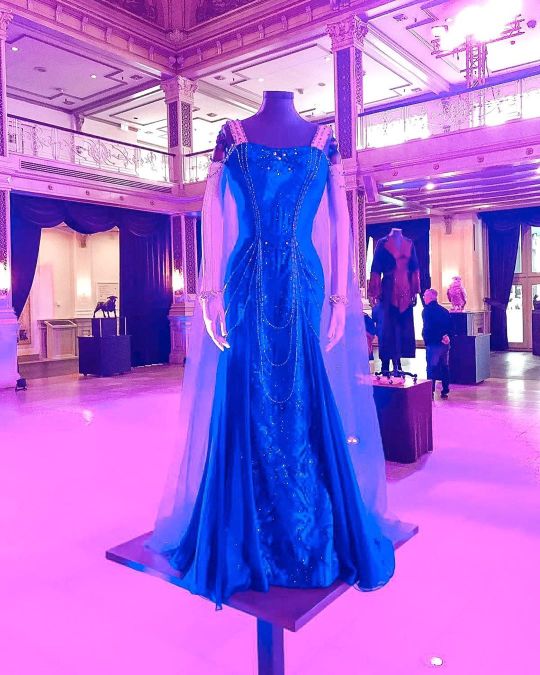
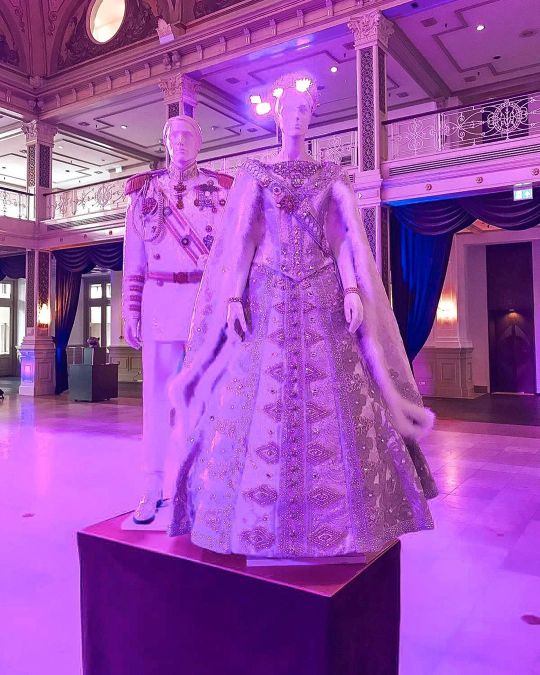
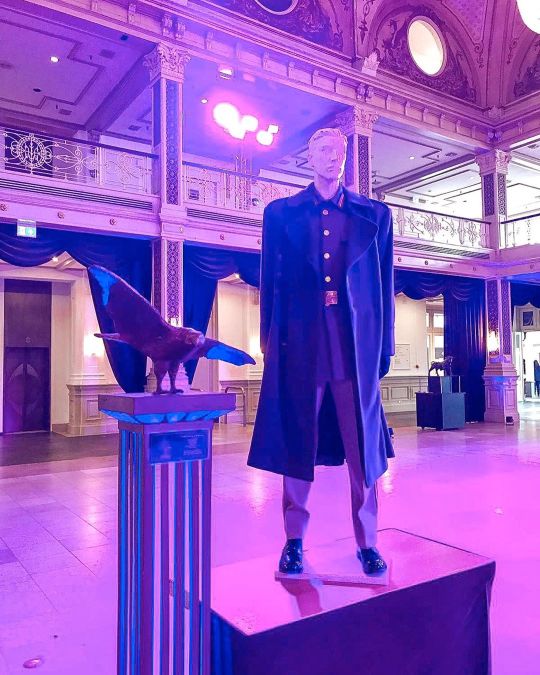
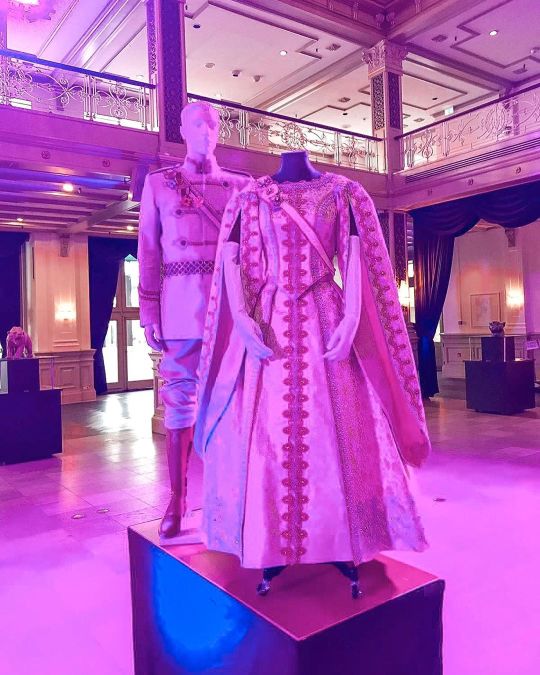
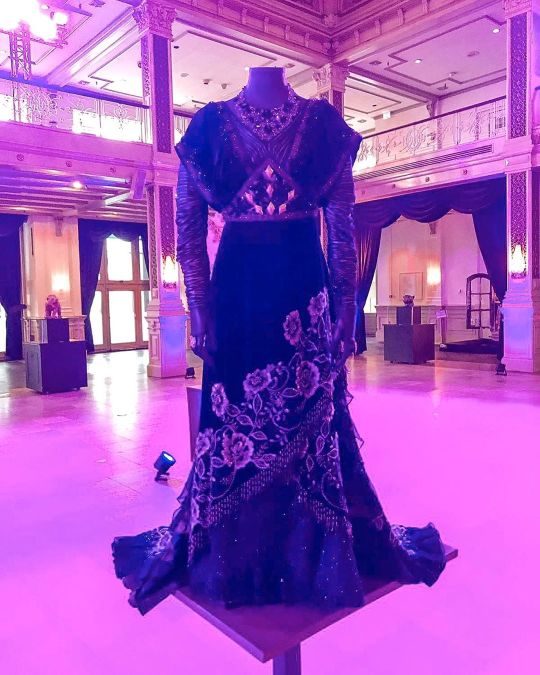
anastasiademusical: Deze schitterende kostuums waren afgelopen zaterdag te bewonderen tijdens onze ANASTASIA tentoonstelling in het @amrathkurhaus! 👑 Heb je het gemist of kon je er niet bij zijn? Je kunt ze natuurlijk ook live bewonderen tijdens de voorstelling! 💜✨ Weet jij van wie deze prachtige kostuums zijn die je hier ziet? #anastasianl#museumnachtdenhaag
#anastasia the musical#anastasia in the hague#anastasia musical#production: the hague#costumes#costumes: the hague#linda cho#costumes: anya#costumes: the romanovs#costume: tsarina#costumes: gleb vaganov#costumes: dowager empress#q#costumes: the romanov sisters
73 notes
·
View notes
Text
god the amount of bad music video needle drop moments. the lighting, the acting, the costumes….. she should be tried at the hague
saltburn was awful lol
18 notes
·
View notes
Text
Oh, HBO, look what happens when you spend money on great writers and period costumes instead of ice dragons.
#if Boardwalk has taught me anything it is how to pick up a Frank Hague references in two seconds or less#save the costumes! Boardwalk movie!#also like all the cast deserve awards but Zoe Kazan is rocking it out of the park#who would've thought it in a Roth adaptation#The Plot Against America#also all TV shows needs to have Hank Greenberg in them that is just a fact
8 notes
·
View notes
Photo

I could not think of anything but his fingers on my neck, his thumb on my lips.
- Tracy Chevalier, Girl with a Pearl Earring
Nicknamed the “Mona Lisa of the North,” Girl With a Pearl Earring is probably Johannes Vermeer's most celebrated work. The painting has captivated so many people throughout history, drawing unprecedented crowds to The Mauritshuis, the art museum in The Hague, Netherlands where it is now housed. It became iconic for the distinct position of the girl, her enigmatic gaze, the colours and the delicate quality of the light.
Girl With a Pearl Earring was not always as popular as it is now. It ended up in Vermeer's patron collection, before it was sold on by his son-in-law. The work was lost for 200 years until a collector bought it for 2 guilders and discovered it was a Vermeer once it had been cleaned. After his death in 1902, it was donated to the Mauritshuis in The Hague, where it has been hung ever since.
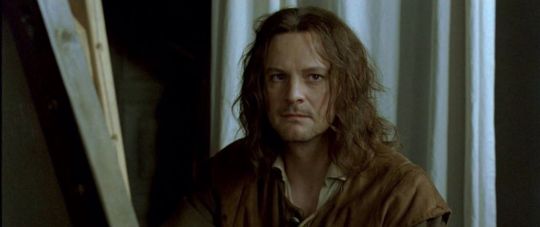
Vermeer himself is as enigmatic as his most famous painting in the history of art. Once nicknamed “the sphinx of Delft”, his native town which he never left, he produced little - only about 34 paintings survive from his oeuvre. He also left behind few biographical traces, though we do know that his wife bore him 15 children. He began his career as a history painter, depicting scenes from ancient Greek and Catholic lore, but from the outset, he trained his eye on women. He soon shifted to the genre scenes of domestic life that made him famous. As the art critic Edward Rothstein wrote, his lifetime project was “an almost metaphysical quest for the precariously poised instant, an ideal we would now consider photographic.”
He is recognised as a master of light who specialised in painting women in sparse domestic interiors, and his pictures are prized in part because they are often suffused with mystery. Unlike some of his Dutch contemporaries, who crammed their compositions full of material objects and narrative detail, Vermeer got a kick out of teasing the viewer and withholding meaning. In one of his canvases, for instance, an elegant couple is engaged in a music lesson - but is the gentleman her tutor, a suitor, or her lover? We will never know.

But what of the Girl herself?
The truth is that despite frenzied speculation (was she the artist’s daughter, or perhaps his mistress?), we will probably never know the identity of the model for Vermeer’s Girl - if there even was one. As such she is even more perplexing. 17th century viewers would have looked at Vermeer’s painting and seen not a portrait but a type of picture known as a ‘tronie’. A ‘tronie’ is a study of a head and shoulders dressed in exotic clothing. The giveaway is the turban: it lends an oriental flavour to the canvas, transporting viewers to a faraway realm of the imagination. While it is possible that someone modelled for it, just as Rubens often painted figures who looked like his wife, it isn’t meant to be a specific person, but someone more generalised, timeless and mysterious - perhaps a sibyl or a figure from the Bible.” Moreover, according to one theory, the impossible pearl, which is too big to be worn in reality, was meant to be understood as a piece of costume jewellery - so adding to the general atmosphere of artifice and make-believe.
This sense of mystery is what attracts people to the Girl. Partly, she’s just gorgeous. But the composition is also very clever. Out of that dark background, she pops into our space looking very much alive - and the gesture is a big part of that. Her mouth is open, which you don’t see that much in Dutch paintings, so she seems as if she is about to talk to you. The viewer is dying to know what she’s going to say. But she doesn’t say anything, thus revealing nothing, and the viewer is left trying to fill in the story.
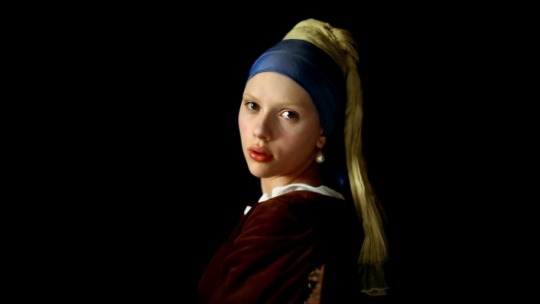
Tracy Chevalier, the novelist herself chipped in with a similar observation that, “The image works because it is unresolved. You can’t ever answer the question of what she’s thinking or how she’s feeling. If it were resolved, then you’d move onto the next painting. But it isn’t, so you turn back to it again and again, trying to unlock that mystery. That’s what all masterpieces do: we long to understand them, but we never will.”
#chevalier#tracy chevalier#quote#vermeer#johannes vermeer#art#painting#dutch#girl with a pearl earring#arts#culture
76 notes
·
View notes